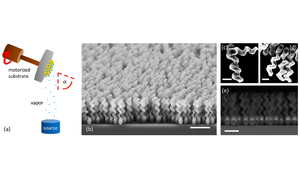Chiral Colloidal Molecules And Observation of The Propeller Effect
2013
Article
pf
Chiral molecules play an important role in biological and chemical processes, but physical effects due to their symmetry-breaking are generally weak. Several physical chiral separation schemes which could potentially be useful, including the propeller effect, have therefore not yet been demonstrated at the molecular scale. However, it has been proposed that complex nonspherical colloidal particles could act as ``colloidal molecules{''} in mesoscopic model systems to permit the visualization of molecular phenomena that are otherwise difficult to observe. Unfortunately, it is difficult to synthesize such colloids because surface minimization generally favors the growth of symmetric particles. Here we demonstrate the production of large numbers of complex colloids with glancing angle physical vapor deposition. We use chiral colloids to demonstrate the Baranova and Zel'dovich (Baranova, N. B.; Zel'dovich, B. Y. Chem. Phys. Lett. 1978, 57, 435) propeller effect: the separation of a racemic mixture by application of a rotating field that couples to the dipole moment of the enantiomers and screw propels them in opposite directions. The handedness of the colloidal suspensions is monitored with circular differential light scattering. An exact solution for the colloid's propulsion is derived, and comparisons between the colloidal system and the corresponding effect at the molecular scale are made.
| Author(s): | Schamel, Debora and Pfeifer, Marcel and Gibbs, John G. and Miksch, Bjoern and Mark, Andrew G. and Fischer, Peer |
| Journal: | JOURNAL OF THE AMERICAN CHEMICAL SOCIETY |
| Volume: | 135 |
| Number (issue): | 33 |
| Pages: | 12353-12359 |
| Year: | 2013 |
| Department(s): | Micro, Nano, and Molecular Systems |
| Bibtex Type: | Article (article) |
| DOI: | 10.1021/ja405705x |
| Links: |
Video - Nanospropellers
|
| Video: | |
|
BibTex @article{ISI:000323536100034,
title = {Chiral Colloidal Molecules And Observation of The Propeller Effect},
author = {Schamel, Debora and Pfeifer, Marcel and Gibbs, John G. and Miksch, Bjoern and Mark, Andrew G. and Fischer, Peer},
journal = {JOURNAL OF THE AMERICAN CHEMICAL SOCIETY},
volume = {135},
number = {33},
pages = {12353-12359},
year = {2013},
doi = {10.1021/ja405705x}
}
|
|






